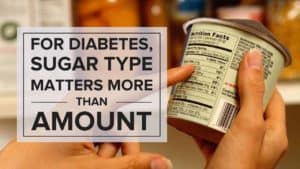The C-Peptide test is an important blood test that determines whether or not your body is still producing a sufficient amount of the hormone insulin, and can be a vital indicator about whether you have type 1 diabetes or type 2 diabetes.
And since determining which type of diabetes you have massively influences the long-term treatment, approach, and potential to reverse diabetes, we're going to take this article to review C-Peptide testing. We'll break down why it's so important, scenarios in which you might want to get one, and most importantly, why no matter the results, you should feel confident about your next steps.
Have you ever heard of the C-peptide test?
It turns out that your C-peptide is an important indicator of your diabetes health and one of the most important of all diabetes biomarkers.
In this article, we’ll cover the basics of C-peptide biology, understand what it tells you about your body’s ability to secrete insulin, how it helps you understand what type of diabetes you are living with, as well as where and how to get your C-peptide tested easily.
What Exactly is C-Peptide?
When the beta cells in your pancreas secrete insulin, they secrete it as a molecule known as “proinsulin.” Proinsulin is an immature version of insulin comprised of an alpha-chain, a beta-chain, and a C-peptide connector. In fact, C-peptide is literally short for connecting peptide.
C-peptide is a polypeptide (small protein) composed of 31 amino acids that connect the alpha-chain and beta-chain together, as you can see in the following diagram:
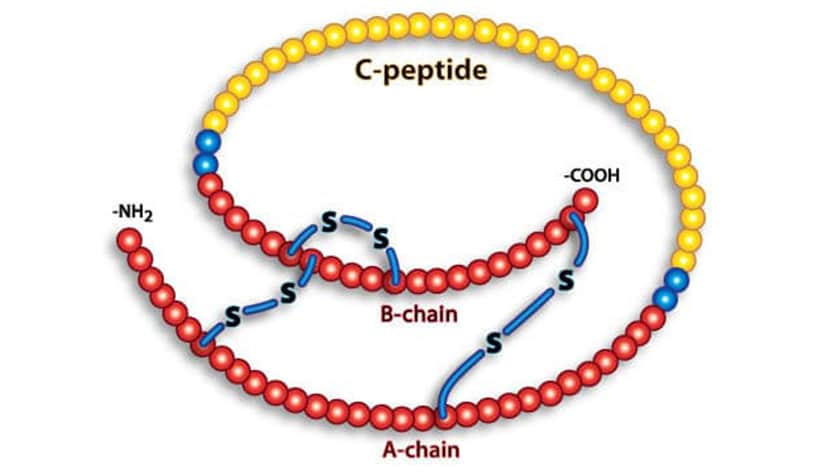
Proinsulin is manufactured in the endoplasmic reticulum then passed to the Golgi apparatus for processing where the C-peptide connector is removed.
When C-peptide is removed from the proinsulin molecule, the alpha and beta chains become linked, and proinsulin turns into insulin, which has specific and powerful biological activity in your blood.
The C-peptide polypeptide was discovered in 1967, and the first C-peptide test was developed in 1972 (1). At the time, this discovery was a landmark insight into the clinical chemistry and physiology of diabetes, because they discovered that insulin and C-peptide are made in equal amounts and that C-peptide remained in the blood for substantially longer periods of time than insulin.
What this means is simple: C-peptide and insulin are present in pancreatic beta cells in equal amounts, however, compared to insulin, C-peptide has a substantially longer (20-30 minutes for C-peptide vs. 3-5 minutes for insulin).
What this means is very important – C-peptide remains in your blood for approximately 5 times as long as insulin and is therefore present in your blood at approximately 5 times the concentration (2).
Why is Your C-Peptide Important?
Because the C-peptide is directly related to your insulin production, understanding whether beta cells are capable of secreting sufficient amounts of insulin to meet your body’s metabolic needs is an absolutely crucial piece of information.
In fact, understanding your C-peptide measurement is so important that researchers believe it to be the most suitable measurement for assessing endogenous insulin secretion (3). Therefore, of you know your level of connection peptide, insulin production levels in your pancreas are easy to calculate, which can be crucial in understanding what type of diabetes you have.
Since the treatment of type 1 diabetes mellitus, type 1.5 diabetes mellitus, prediabetes, type 2 diabetes mellitus, and gestational diabetes mellitus each require different treatment plans, being misdiagnosed with the incorrect type of diabetes can lead to an improper course of treatment, years of frustration, and rapidly declining health.
An accurate C-peptide measurement will provide you and your doctor with a quantitative assessment of the ability of your pancreatic beta cells to secrete insulin. This information allows you to answer the following questions:
Let’s dive into each of these questions individually, to get a better understanding of how your C-peptide value influences your diabetes treatment (or reversal) regimen.
What Type of Diabetes Are You Actually Living With?
Every year, millions of people are misdiagnosed with type 2 diabetes rather than type 1 diabetes or type 1.5 diabetes because they fail to measure their C-peptide levels at an early stage in the disease process.
The C-peptide test will tell you what type of diabetes you are actually living with (4), and help you differentiate between an autoimmune version of diabetes (with extremely low insulin production) and lifestyle-related diabetes (with medium to high insulin production).
Recent guidelines developed by the American Association of Clinical Endocrinologists (AACE) and the American College of Endocrinology (ACE) dictate that a C-peptide should be used when there is doubt about what type of diabetes a patient is living with.
In addition, a recent systematic review suggested that the C-peptide test be used as the principal baseline measure of insulin deficiency (5).
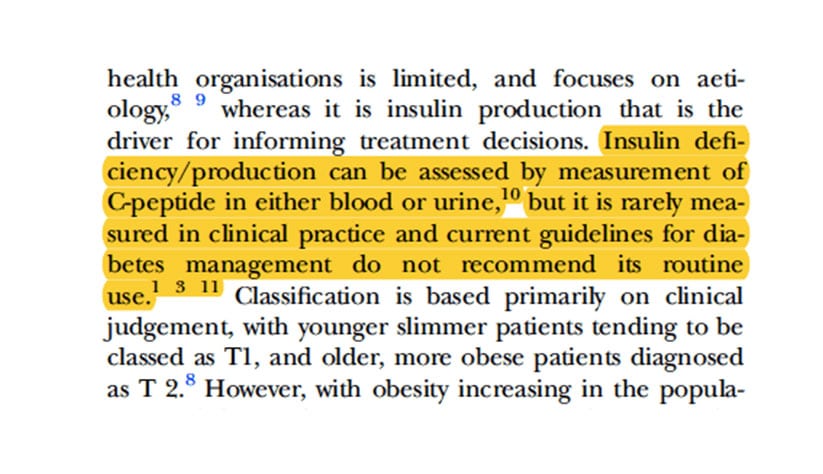
Knowing your C-peptide levels can determine the entire course of your diabetes treatment, and allow you to differentiate between “insulin sufficient” and “insulin deficient.”
Although it is possible to make an educated guess about what type of diabetes you are living with, a C-peptide blood test gives you and your doctor a much more accurate insight into your diabetes health.
Are You Living with Autoimmune Diabetes (Type 1 or Type 1.5 Diabetes)?
If you are living with an autoimmune version of diabetes (either type 1 or type 1.5 diabetes), then your C-peptide levels will most likely be significantly lower than if you are living with prediabetes or type 2 diabetes.
But what exactly is type 1.5 diabetes? Type 1.5 diabetes is increasing in prevalence around the world and is often referred to as Latent Autoimmune Diabetes in Adults (LADA).
Once considered rare conditions, type 1 diabetes and LADA have been on the rise since the 1950s (6,7).
Living with type 1.5 diabetes (the adult-onset, slow-progressing version of type 1 diabetes) means that your pancreas is still capable of producing insulin, but the presence of one or more autoantibodies against beta-cells leads to the slow destruction of beta cells over time.
LADA has characteristics of both type 1 diabetes and type 2 diabetes and is often misdiagnosed as other forms of diabetes, resulting in the wrong treatment (8).
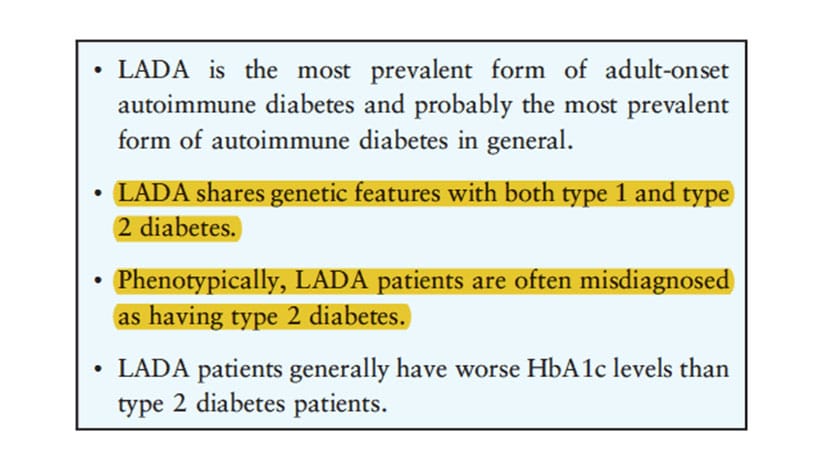
It is currently unknown how many type 1.5 patients are misdiagnosed with other forms of diabetes, but some estimate it could be as many as 1 out of every 10 diabetes patients (9), and some researchers believe that type 1.5 diabetes is the most prevalent form of autoimmune diabetes in general (10).

It’s important to note here that medical scientists are now recognizing that type 1.5 diabetes is not really one type of diabetes. The condition occurs on a spectrum and each patient must be treated as an individual and not as a generic “type.”
The treatment strategy (such as whether or not insulin is used and how much insulin is needed) will likely change over time as type 1.5 diabetes worsens or improves (11,12). C-peptide levels should be monitored routinely in addition to other important diabetes biomarkers.
The Immunology of Diabetes Society has established 3 main criteria for establishing a diagnosis of LADA. These three factors must be present in order for a patient to be diagnosed with LADA:
On the other hand, those living with type 1 diabetes experience a “severe loss of insulin secretion” characterized by multiple autoantibodies and a dangerously low C-peptide value.
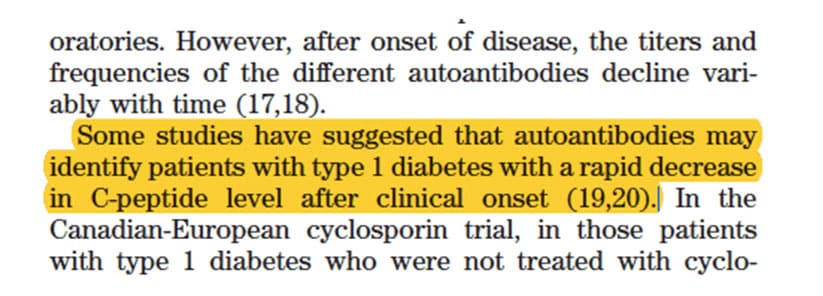
An overwhelming majority of those living with type 1.5 diabetes test positive for only one autoantibody, resulting in a slow-progressing loss of insulin secretion (10).
Evidence of destruction to beta cells is currently accepted as a diagnostic tool for autoimmune diabetes. Those living with type 1 diabetes often require exogenous insulin almost immediately after diagnosis, whereas those with type 1.5 diabetes may not require insulin therapy for between 6 months and 5 years after diagnosis.
It turns out that people with LADA are often misdiagnosed with type 2 diabetes for three main reasons:
Case Study: Type 1.5 Diabetes Misdiagnosis
Anna is a classic example of someone who was misdiagnosed with type 2 diabetes for 11 years.
Although she diligently reduced her carbohydrate intake and total calorie intake in addition to taking multiple oral diabetes medications, her blood glucose levels were very difficult to control.
She experienced high blood glucose even after eating non-starchy vegetables and felt shameful that she couldn’t control her blood glucose. She was so desperate to reverse type 2 diabetes that she starved herself with juice fasts. Even this did not help.
Anna joined our small group coaching program and Cyrus asked some poignant questions to gain an understanding of why Anna’s blood glucose was constantly elevated even though she was indeed following a truly low-fat, plant-based, whole-food diet.
When Cyrus asked her a simple question: “What is your C-peptide level?” Anna responded, “It is normal.” Cyrus asked “No, what was the actual number?” and Anna replied, “my C-peptide is 0.8.”
Cyrus then explained to her that with a C-peptide value of 0.8 in conjunction with what she had seen when applying a low-fat, plant-based, whole-food diet, her pancreas was not producing sufficient insulin to meet her metabolic needs.
After 11 years of living with the wrong medical diagnosis, Anna is now able to effectively control her blood glucose by discontinuing oral medication and injecting small amounts of basal and bolus insulin.
She subsequently got a diabetes islet antibody test and tested positive for 1 autoantibody, confirming a new diagnosis of type 1.5 diabetes. Thanks to both the C-peptide and diabetes antibody tests, Anna now lives in full control of her diabetes health.
Type 1.5 diabetes is also likely in patients diagnosed with type 2 diabetes as an adult who are lean and do not have the metabolic syndrome (high blood pressure, high cholesterol or triglycerides, and excess fat around the waist), especially if that patient follows a low-fat, plant-based, whole-food diet and is physically active.
Because a low-fat, plant-based, whole-food lifestyle is so effective at preventing and reversing type 2 diabetes, if you are unable to control your blood glucose after 3 months, then we recommend testing your C-peptide and getting a diabetes antibody panel.
We recommend getting your c-peptide tested first. Once you have that information, you can decide if it’s worth the time and effort to test for diabetes antibodies.
Learning from Your Blood Sample: How Much Damage Have Your Beta Cells Accumulated?
Knowing how much damage has been done to your beta cells over time is an important determinant of whether your body requires exogenous insulin or not.
If your beta cells are still functioning properly, and you have residual beta-cell function, a low fat, plant-based, whole-food diet combined with frequent exercise and adequate sleep can help you achieve non-diabetic blood glucose without the need for medications or insulin injections.
If your C-peptide blood sample reveals significant destruction of your pancreatic beta cells, it is unlikely that you will be able to achieve non-diabetic blood glucose values without the use of exogenous insulin, regardless of how strict you are with your diet and exercise regimen.
If you have been diagnosed with type 2 diabetes on the assumption that you are insulin resistant, even though your C-peptide value was never measured, then taking a C-peptide blood sample can help you avoid unnecessary oral diabetes medications and years of unnecessary side effects.
What Are Your Chances of Reversing Prediabetes or Type 2 Diabetes Without the Need for Diabetes Medications?
If you have been diagnosed with either prediabetes or type 2 diabetes, you may be wondering the answer to a simple question: Can I achieve non-diabetic blood glucose values (low blood sugar) once again?
Many people ask us if it’s possible to live free of diabetes medications by making consistent changes to their diet and movement patterns. While this is possible, there are a few important things to take into account.
Using conventional treatment, type 2 diabetes mellitus is a progressive disease in which approximately 50% of individuals require insulin therapy within 10 years of diagnosis resulting from insulin resistance, the deterioration of beta-cell function, and reduced insulin secretion over time (14), (15).
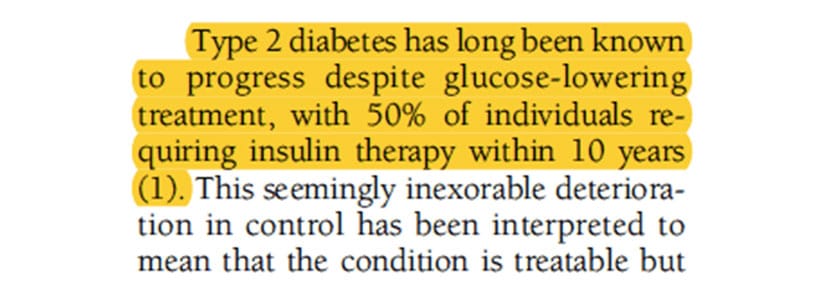
Using a low-fat, plant-based, whole-food diet combined with adequate physical exercise, you can reverse prediabetes and type 2 diabetes mellitus in 99% of cases, when there is still sufficient insulin production.
In this case, your body is producing plenty of insulin (as measured by a high C-peptide value), but your lifestyle has created a state of insulin resistance. By optimizing your diet and movement patterns, you can reverse insulin resistance and control your blood glucose (get back to a safe, low blood sugar level) without diabetes medications.
A high C-peptide value indicates that your beta cells are capable of manufacturing sufficient insulin, and by switching to a low-fat, plant-based, whole-food diet it’s possible to completely reverse insulin resistance and eliminate your need for diabetes medications using your food as medicine (16–19).
A medium C-peptide value indicates that you have adequate insulin production to fully reverse prediabetes or type 2 diabetes mellitus, but that it’s imperative to maximize your insulin sensitivity in order to prevent beta cells from becoming exhausted over time.
A low C-peptide measurement means that your beta cells have been permanently impaired. In this situation, you will likely require exogenous insulin to control your blood glucose for the rest of your life.
If you are living with type 2 diabetes and have been told to inject insulin unaware of your C-peptide value, then you are in the same situation as millions of people around the world. The vast majority of these patients have a medium or high C-peptide value and can fully reverse insulin resistance using lifestyle modification.
However, while it is true that type 2 diabetes can often be fully reversed, this is not always the case.
In the progression towards type 2 diabetes mellitus, beta cells in your pancreas can begin hypersecreting insulin as early as 20 years before diabetes is even detected, in an effort to keep you at a low blood sugar level and prevent your blood glucose from elevating as a result of increasing insulin resistance.
As you can see in the image below, insulin is not the limiting factor in the early stages of the disease process. As insulin resistance progresses, beta cells increase insulin production – sometimes by as much as 500% of normal – in order to protect against elevated blood glucose.
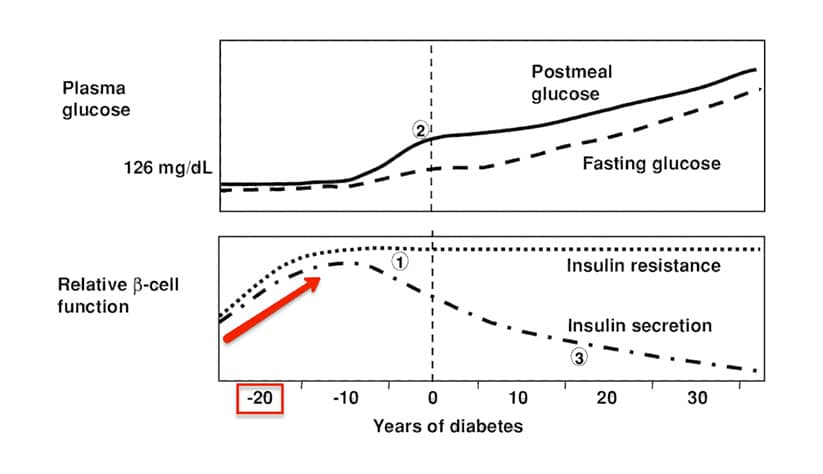
Image courtesy of this research paper
Over time, if insulin resistance continues to develop due to high-fat feeding, the beta cells in your pancreas become overworked, resulting in beta cell death. When this happens, you develop a state of hypoinsulinemia (impaired insulin production), resulting in high blood glucose in the fasting and post-meal states.
Your C-peptide values follow the same progression as insulin. When you are hyperinsulinemic (producing excess insulin), your C-peptide value increases accordingly, and when beta cells permanently lose their ability to produce sufficient insulin, your C-peptide value falls significantly.
There is strong scientific evidence showing that lifestyle change can help restore beta-cell function, however optimal function may never be completely restored (20). By testing your C-peptide level, you and your doctor can find out how much your beta cells are capable of secreting insulin, or if they have been permanently impaired.
High C-peptide levels indicate that your beta cells are still functioning properly, and your likelihood of completely getting off of oral hypoglycemic drugs and/or insulin injections is very high, whereas low C-peptide levels indicate that your beta-cell function has been permanently impaired and you may likely require insulin to control your blood glucose.
What is the Difference Between a Fasting and Stimulated C-Peptide Test?
There are two types of C-peptide tests:
The fasting C-peptide test is self-explanatory. A stimulated C-peptide test can be performed in one of 3 ways:
The purpose of stimulated C-peptide testing is to measure how much insulin your pancreas produced in the hour after a carbohydrate challenge. The amount of C-peptide in your blood reveals how effective your pancreas is at secreting insulin and C-peptide in response to rising blood glucose.
The Immunology of Diabetes Society currently recommends using both the fasting and stimulated c-peptide tests at diagnosis and annually (21).
Reference ranges for the stimulated C-peptide test are shown below (22).
Do Doctors Recommend Testing Your C-Peptide Levels?
At Mastering Diabetes, we partner with many doctors and provide education as well as ongoing support for their patients. We believe that a doctor can be your greatest ally in restoring your health. For this reason, we educate our clients on how they can partner with their doctors to maximize their metabolic health.
Despite the advancements that have been made in the understanding and treatment of diabetes over the past century – including the discovery of C-peptide and the subsequent invention of C-peptide testing in 1972 – lifestyle change education for physicians is often lacking in medical school.
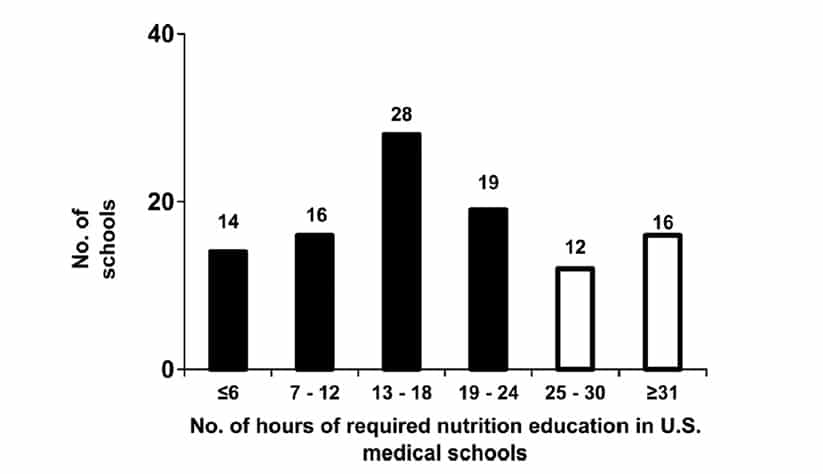
Because of this, physicians are rarely educated about the importance of a C-peptide test for their patients. In addition, much of medical school education (as well as post-graduate continuing education) is funded by pharmaceutical companies (22,23).
These companies have a vested interest in ensuring that type 2 diabetes patients remain unaware that their condition is preventable and reversible with a low-fat, plant-based diet.
Always remember one thing – physicians are NOT to blame for a lack of education about lifestyle change (23–25). Until the medical system begins to place a larger emphasis on evidence-based approaches to reversing diabetes, physicians will remain in the dark.
Although this can sound grim, bordering on a conspiracy against public health, the positive side is that most doctors truly want their patients to get well and are willing to work with you when you know how to approach them in the right way.
If you are second-guessing your diagnosis or requesting a different treatment plan, your doctor may become defensive or uncooperative, or even discharge you as a patient. We teach our clients in the Mastering Diabetes Program exactly how to approach their doctor with factual information in a way that will make them more open to the evidence-based science of lifestyle change.
How To Get Your C-Peptide Blood Test
Here’s the good news – it’s very easy to get your c-peptide level tested. It is an inexpensive blood test that you can request from your doctor, or you can order the test for yourself online and schedule to have your blood drawn at a local Labcorp or Quest Diagnostics walk-in facility.
You can usually schedule your blood draw for the same day you place your order, and there is little to no wait time. Most facilities are open on weekends, so paying out of pocket is often more convenient than waiting to see your primary care physician or endocrinologist.
If you are going to use the latter method, we suggest ordering from one of the following online laboratories:
Simply select where you would like to get your blood drawn, enter your credit card information, and then take the order form to your local facility. The results are quick, and often ready in 1-3 days.
Interpreting Your C-Peptide Lab Results
We recommend using the following guidelines to interpret your C-peptide test results. As you can see, your C-peptide results are best interpreted in conjunction with an islet antibody test – interpreting the results of both tests together provides the most accurate information.
*Please note that these guidelines are not considered medical advice and are merely the opinion of Mastering Diabetes to provide a C-peptide reference range to help guide your C-peptide interpretation at a glance. For a C-peptide test, normal range can be slightly different for everyone, so we encourage you to consult your medical professional to interpret your own results.
With that said, here are some benchmarks.
If your fasting C-peptide is less than 1.0 ng/mL:
Your endogenous insulin levels are very low, which means that you fall into one of the 3 categories below:
Your fasting C-peptide is 1.0 – 2.0 ng/mL:
Your endogenous insulin production is medium, which means that you fall into one of the following 3 categories:
Your fasting C-peptide is 2.0 ng/mL or above:
Your endogenous insulin production is medium-to-high, which means that you fall into one of the following 3 categories:
The following table summarizes our C-peptide guidelines:
Low C-Peptide (<1.0 ng/mL) | Medium C-Peptide (1.0-2.0 ng/mL) | High C-Peptide (2.0 ng/mL+) | |
|---|---|---|---|
Negative Antibody Test | Type 2 diabetes with low insulin production (Insulin likely) | Type 2 diabetes with impaired insulin production (Insulin unlikely) | Type 2 diabetes with high insulin production (Insulin unlikely) |
Positive (1 AB) | Type 1.5 diabetes (Insulin necessary) | Type 1.5 diabetes (Insulin necessary) | Type 1.5 diabetes (Insulin necessary over time) |
Positive (2+ ABs) | Type 1 diabetes (Insulin necessary) | Type 1 diabetes (Insulin necessary) | Type 1 diabetes (Insulin necessary over time) |
Take-Home Message
We hope this gives you a clear understanding of the importance of your C-peptide value in the course of your diabetes treatment protocol.
We consider the C-peptide test to be one of the most valuable diagnostic tests available today because together with an antibody test, they can definitively guide your method of diabetes treatment or reversal.
Lower Your A1c and Get to Your Ideal Body Weight ... Guaranteed
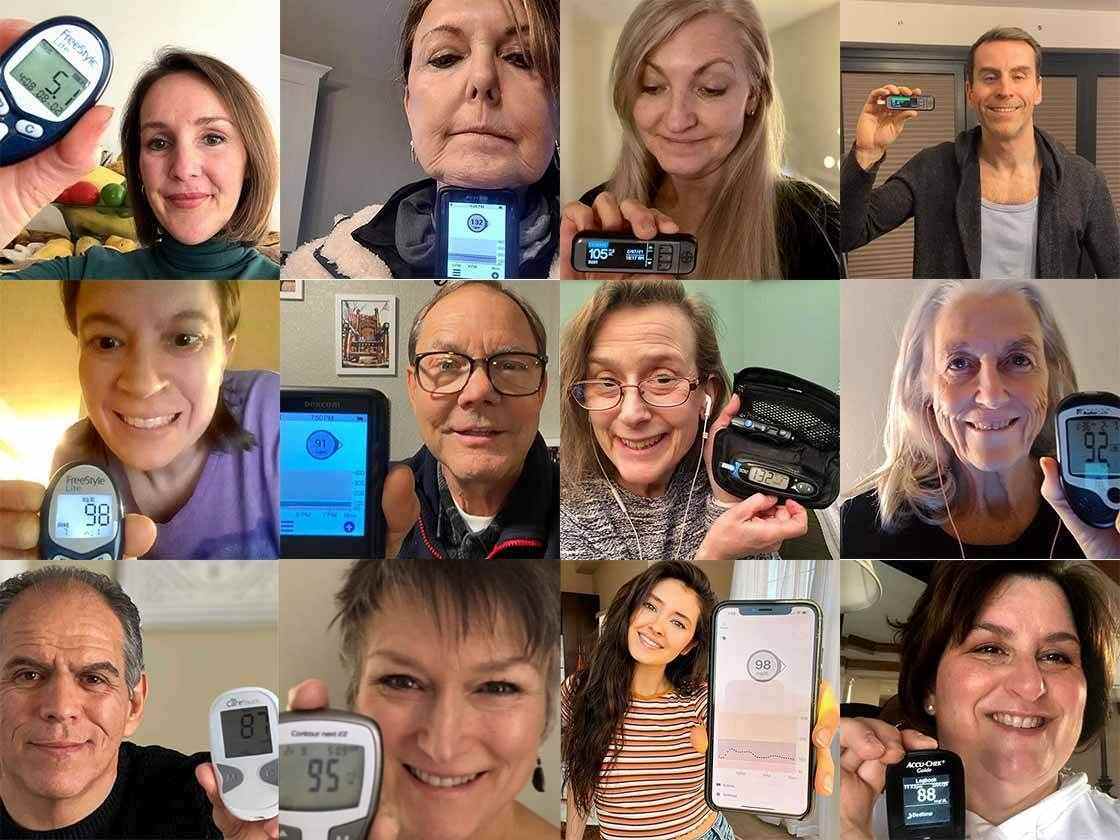
Your results are guaranteed. Join more than 10,000 ecstatic members today
Personalized coaching puts you in immediate control of your diabetes health, helps you gain energy, improves your quality of life, and reduces or eliminates your meds.



